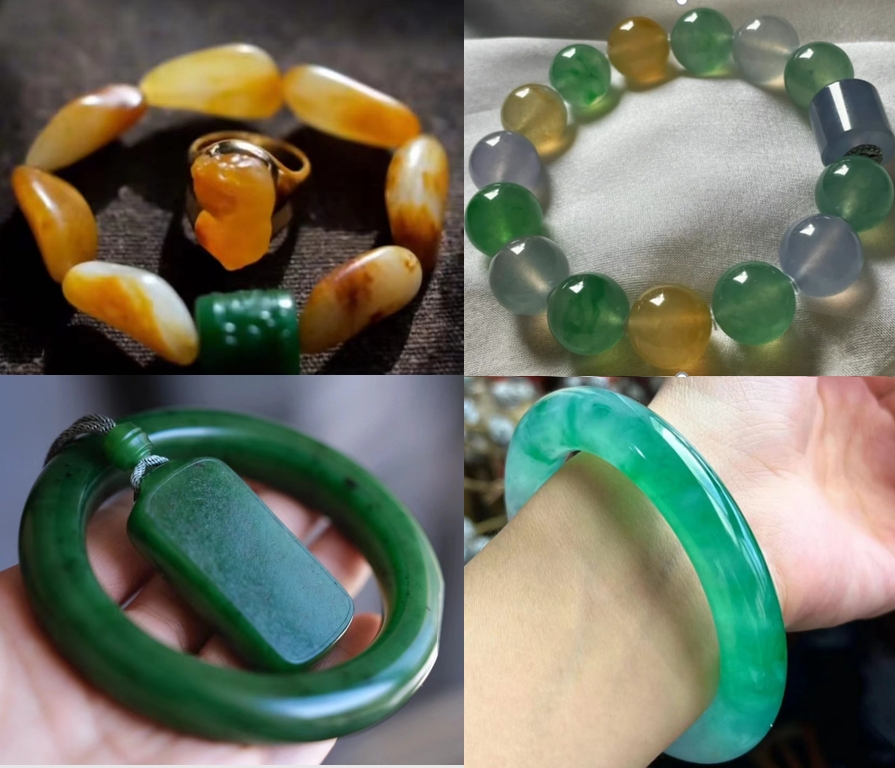
When it comes to jade, two primary types stand out: Nephrite and Jadeite. Though both are revered for their beauty and cultural significance, they are distinct in their composition, appearance, and historical usage. In this blog post, we’ll explore the key differences and unique qualities of Nephrite and Jadeite, helping you appreciate the nuances of these captivating stones.
Composition and Structure
Nephrite: Nephrite is a variety of the amphibole mineral actinolite. Its structure comprises a microcrystalline interlocking fibrous matrix, contributing to its exceptional toughness. Nephrite typically contains calcium, magnesium, and iron.
Jadeite: Jadeite belongs to the pyroxene group of minerals, characterized by a dense, granular structure composed mainly of sodium and aluminum. Its crystalline structure is tighter and more granular compared to Nephrite.

Appearance and Color
Nephrite: Nephrite jade is commonly found in shades of green, ranging from pale to dark. It can also appear in white, brown, yellow, and even black. Among the most prized varieties are single-seed Nephrite pieces from Xinjiang’s Hotan region that exhibits creamy-white color and beautifully mottled surface colors.
Jadeite: Jadeite exhibits a broader spectrum of colors, including vibrant greens, lavender, white, yellow, pink, and black. The most prized variety is Imperial Green Jade, which features a rich emerald-green hue with high translucency. Jadeite’s colors are often more vivid and varied compared to Nephrite.

Geographical Origins
Nephrite: Major sources of Nephrite include China, New Zealand, Russia and Canada. Historically, Nephrite jade has been extensively used in Chinese art and culture for thousands of years, symbolizing purity and moral integrity.
Jadeite: Jadeite is predominantly found in Myanmar (Burma), renowned for producing some of the finest quality jadeite globally. It also occurs in countries such as Guatemala, Japan, and the United States, gaining popularity during the Qing Dynasty in China.

Historical and Cultural Significance
Nephrite: With a history spanning over 7,000 years in Chinese culture, Nephrite jade is carved into intricate artifacts, jewelry, and ceremonial objects. It is often associated with Confucian virtues and is believed to bring protection, health, and good fortune.
Jadeite: Jadeite gained prominence in Chinese culture during the 18th century, particularly among the elite. Its vivid colors compared to Nephrite made it highly desirable. It also holds significance in Mesoamerican cultures, used in religious and ceremonial contexts.

Durability and Usage
Nephrite: Renowned for its toughness, Nephrite jade is less prone to chipping or breaking, making it ideal for intricate carvings and durable jewelry.
Jadeite: Although harder than Nephrite, Jadeite is more brittle, requiring careful handling to avoid damage. Its hardness makes it suitable for high-end jewelry and fine art pieces.

Market Value
Nephrite: While generally more abundant and less expensive than Jadeite, high-quality single-seed Nephrite specifically from Xinjiang’s Hotan region commands exceedingly high prices and holds significant investment value. It is exceptionally rare and dwindling, making it irreplaceable. Additionally, artworks with historical significance or exceptional craftsmanship can fetch high prices.
Jadeite: High-quality Jadeite is exceptionally rare and holds extraordinary value, particularly the Imperial Green Jade variety. Its market value is driven by its immense popularity and the widespread demand for its vibrant colors and translucency. Jadeite jades are far more recognized, understood, and worn worldwide compared to Nephrite jades.

Aesthetic Differences
Nephrite: Nephrite’s aesthetic, particularly Hotan jade from China’s Xinjiang region, is more understated and traditional. Its appeal lies in its subtle, internal luster, fine grain, and rich, creamy texture. Unlike Jadeite, it should not be too translucent or glossy. Nephrite embodies a cultural heritage that values warmth, maturity, and subtlety, often appreciated by older, more experienced collectors. It is not only worn but also handled for its tactile qualities, categorizing it under traditional Chinese scholarly objects (文玩).
Jadeite: When appreciating Jadeite, the focus is on its translucency, luster, vivid color, and fine texture. The best Jadeite pieces are clear, glossy, brightly colored, and densely structured without visible inclusions. Jadeite’s aesthetic appeals to modern, commercial tastes, often making it a standout piece meant to attract attention.

Both Nephrite and Jadeite jade hold timeless beauty and cultural significance, each with unique characteristics. Whether you are drawn to the historical depth of Nephrite or the vibrant colors of Jadeite, understanding these differences can enrich your appreciation of jade. At Hermit Jade, we celebrate the rich heritage and allure of both Nephrite and Jadeite. Explore our collection to find the perfect jade piece that resonates with your personal style and cultural appreciation.
